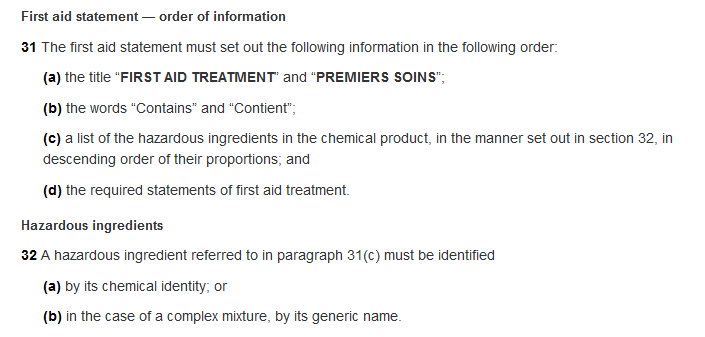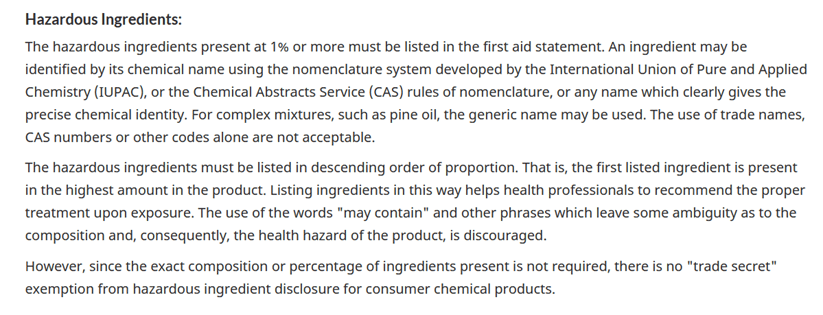Canadian Consumer Compliancy: CCCR 2001 – Contains Statement Requirements
By: Kirsten Alcock, Manager of Product Safety, email
The Canadian Consumer Chemicals and Containers Regulations, 2001, contains the regulations that we must follow when classifying a non-registered product for Canada. There are many requirements for CCCR 2001 consumer labels in Canada and in our experience, we have found that many of them that are on the shelf in Canada do not meet compliance.
As I’ve stated in the past, one of the biggest mistakes I find out there is what is referred to as the Contains Statement. This is a statement that is required within the body of the First Aid requirements on your CCCR label. It is not something that is required for all classifications under the CCCR but if your classification has this requirement, please make sure that you are putting the information onto your label correctly. Your product label must disclose all the chemicals that are contributing to the hazard of your product. They must be disclosed in descending order of their proportions (i.e. top to bottom).
This is the information as provided by the CCCR regulations:
The requirements indicate that the hazardous ingredient must be identified by its chemical identity or in the case of a complex mixture, by its generic name. I have seen many companies take many liberties with this. The CCCR reference manual provides further guidance on this as there are so many products improperly labeled. If you think it’s too generic, it likely is. Make sure you are using a proper chemical name.
What is a hazardous ingredient in the eyes of the CCCR and how do they advise you disclose it? The following is taken from the CCCR reference manual and we highly suggest you follow these suggestions.
As you can see from the above, Health Canada is advising disclosing the ingredient by its chemical name using the IUPAC or CAS rules of nomenclature. I can assure you that placing the word ‘surfactant’ or ‘primary alcohol’ in your contains statement does not meet compliance and puts you at risk of having your product recalled from the shelf. Do you want to take that risk? Recalls are not cheap and can cause issues with the companies you sell to.
Unlike workplace products, where you can claim Trade Secret, it is NOT permitted for your consumer product in Canada.
If you are having difficulty determining the requirements for your compliant consumer CCCR 2001 label in Canada and would like our help, do not hesitate to contact us. We have been classifying products for consumer regulations for more than 40 years and have the expertise in-house to help you keep your product compliant with the current regulations as they stand today.
For further information on our services, please contact:
Contact:
Dell Tech
Kirsten Alcock, B.Sc. (Hons)
Manager, Product Safety Group
519-858-5074
kirsten@delltech.com
Dell Tech has provided professional, confidential consulting services to the chemical specialty
industry in Canada, the USA, Europe, and Asia for the last 40 years.
Contact us today for more information.







